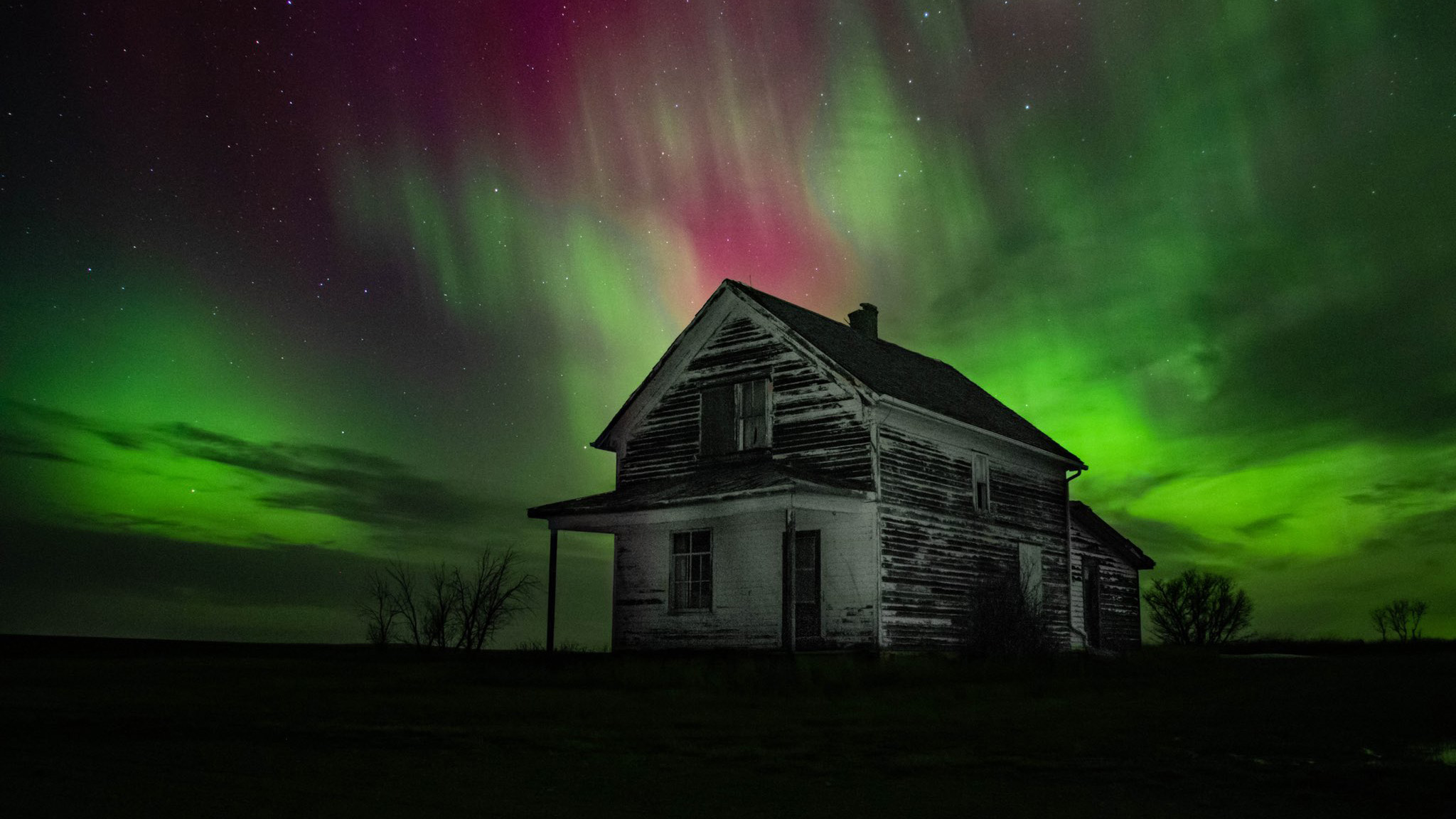Stunning northern lights from intense solar storms thrill stargazers (photos)
'The night sky offers so much to see from our small space on Earth.'
A series of solar storms aimed at Earth this week have supercharged the Earth's auroras, creating dazzling displays like this view over a rural cabin in Canada captured by an astrophotographer.
Photographer Jenny Hagan captured this photo of the northern lights as they rippled with green and red hues over west central Saskatchewan amid several outbursts from the sun in recent days.
"The night sky offers so much to see from our small space on Earth," Hagan told Space.com in an email.
Related: Hyperactive sunspot just hurled a huge X-class solar flare into space
On Wednesday night and Thursday early morning, skywatchers like Hagan saw auroras in Canada, the northern parts of the U.S. and in New Zealand from several moderate-sized solar flares earlier in the week.
Satellites including NASA's Solar Dynamics Observatory caught the flaring action from space, and Hagan saw the resulting light show effects of coronal mass ejections (streams of irradiated solar particles) hitting Earth's magnetic field during the space weather event. Hagan captured the image (and several more, as you can see in this story) with a Canon 80D, mounted on a tripod and open for a three-second timelapse. "The night sky offers so much to see from our small space on Earth," Hagan said, adding that "satellites, and stars contribute to the light that break through the dark.
If you need equipment to capture the best aurora, consider our best cameras for astrophotography and best lenses for astrophotography to make sure you're ready. We also have a beginner's guide on how to photograph the aurora.
Breaking space news, the latest updates on rocket launches, skywatching events and more!
Hagan was also able to capture a stunning timelapse of the sky from her vantage point.
Short time lapse of last nights March 30th #Aurora #Saskatchewan #Canada near Laporte Sk pic.twitter.com/lTs5GcwH4NMarch 31, 2022
Ahhh. Working in a quick time lapse of this beautiful #aurora March 30 taken near Laporte #Saskatchewan finally getting some images pulled from the camera ❤️❤️ pic.twitter.com/CCXb1maN8qMarch 31, 2022
"Just south of the small village of Laporte ... I set up by an old 1950s abandoned farm house," Hagan told Space.com in an e-mail. Hagan was working in the prairie (grassland) nearly three hours southwest of the city of Saskatoon.
"Sights like these are plentiful here in rural Saskatchewan, the land of the living sky," Hagan continued, "and the relics of the past offer up great foreground for the wide open views of our sky." You can find more of Hagan's work at BackRoadPhotos.ca and on Instagram.
Clouds took over now but managed to get a few great shots of the #aurora tonight near Laporte #saskatchewan pic.twitter.com/OTf2Un7h5HMarch 31, 2022
Hagan was far from the only skywatcher to see the northern lights this week from the sun's flares. Here's just a taste of what skywatchers with clear dark skies in the northern parts of North America saw and shared online.
I literally can’t believe this happened tonight. 8 meteorology students, 3 mechanical engineering students, 2 journalists, and 1 meteorologist all watching the northern lights together. This went way better than imagined. So, so happy. #sdwx #Aurora @sdsmt #NorthernLights pic.twitter.com/2SKkEhyqKuMarch 31, 2022
The Bz wasn’t too friendly for most of the night, but the typical 1-2am “aurora hour” came through with quite a display! #akwx #aurora pic.twitter.com/PKaFndganmMarch 31, 2022
Here's a little timelapse of the northern lights explosion from last night in Churchill, MB. Look how fast the aurora moves - and these were only two second exposures! We had some incredible coronas.#aurora #northernlights #auroraborealis pic.twitter.com/NVq0xOLHwBMarch 31, 2022
I was fortunate enough to have turned onto a random North Dakota dirt road where this tractor was practically waiting for me while the lights danced behind it. This is probably my favorite shot from last night’s Aurora show in ND. I’m still in awe!#ndwx #aurora #photography pic.twitter.com/vQ4VWfMj4CApril 1, 2022
Got a good surge!! This is my first time seeing the aurora #aurora#cowx pic.twitter.com/AMdWmHE5QZMarch 31, 2022
If you captured a stunning photo of the northern lights let us know! You can send in images and comments to Space.com by emailing spacephotos@space.com. Be sure to let us know your name, where you were observing from and what it was like to see the auroras.
Follow Elizabeth Howell on Twitter @howellspace. Follow us on Twitter @Spacedotcom or on Facebook.

Elizabeth Howell (she/her), Ph.D., was a staff writer in the spaceflight channel between 2022 and 2024 specializing in Canadian space news. She was contributing writer for Space.com for 10 years from 2012 to 2024. Elizabeth's reporting includes multiple exclusives with the White House, leading world coverage about a lost-and-found space tomato on the International Space Station, witnessing five human spaceflight launches on two continents, flying parabolic, working inside a spacesuit, and participating in a simulated Mars mission. Her latest book, "Why Am I Taller?" (ECW Press, 2022) is co-written with astronaut Dave Williams.

